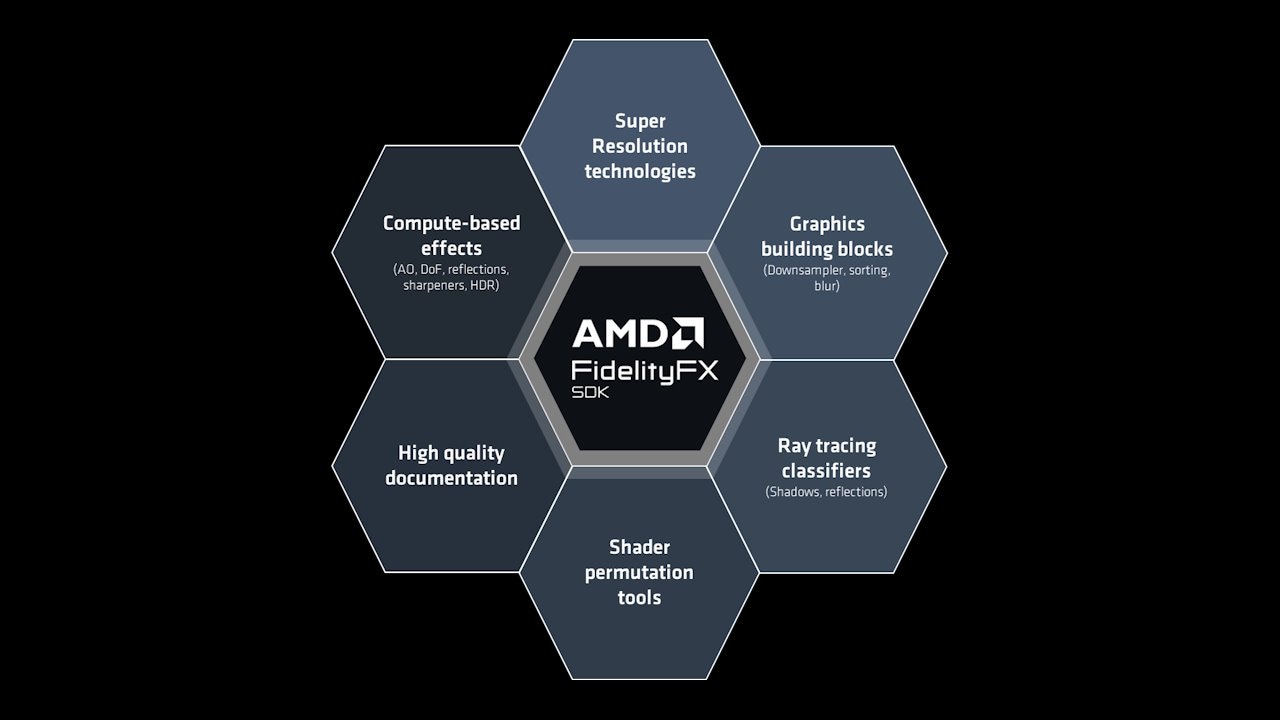
AMD FidelityFX™ SDK v1
The AMD FidelityFX SDK v1 is our easy-to-integrate solution for developers looking to include FidelityFX v1 features into their games.
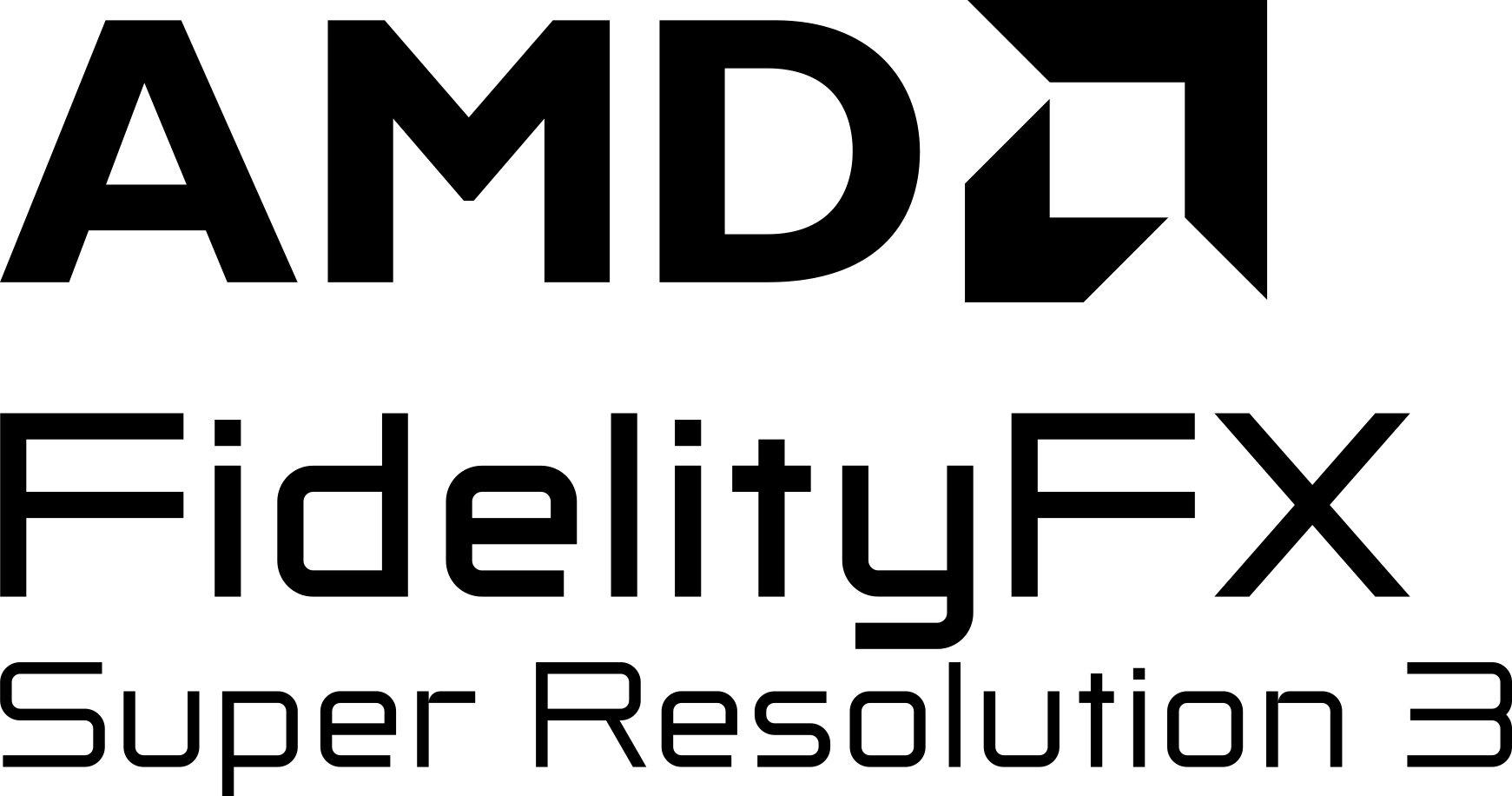
Today sees the release of “Forspoken” and “Immortals of Aveum” patches which include AMD FidelityFX Super Resolution 31 (FSR 3) technology. Thanks to Luminous Productions, Ascendant Studios, and Enduring Games for being our FSR 3 launch partners and making these integrations available to gamers.


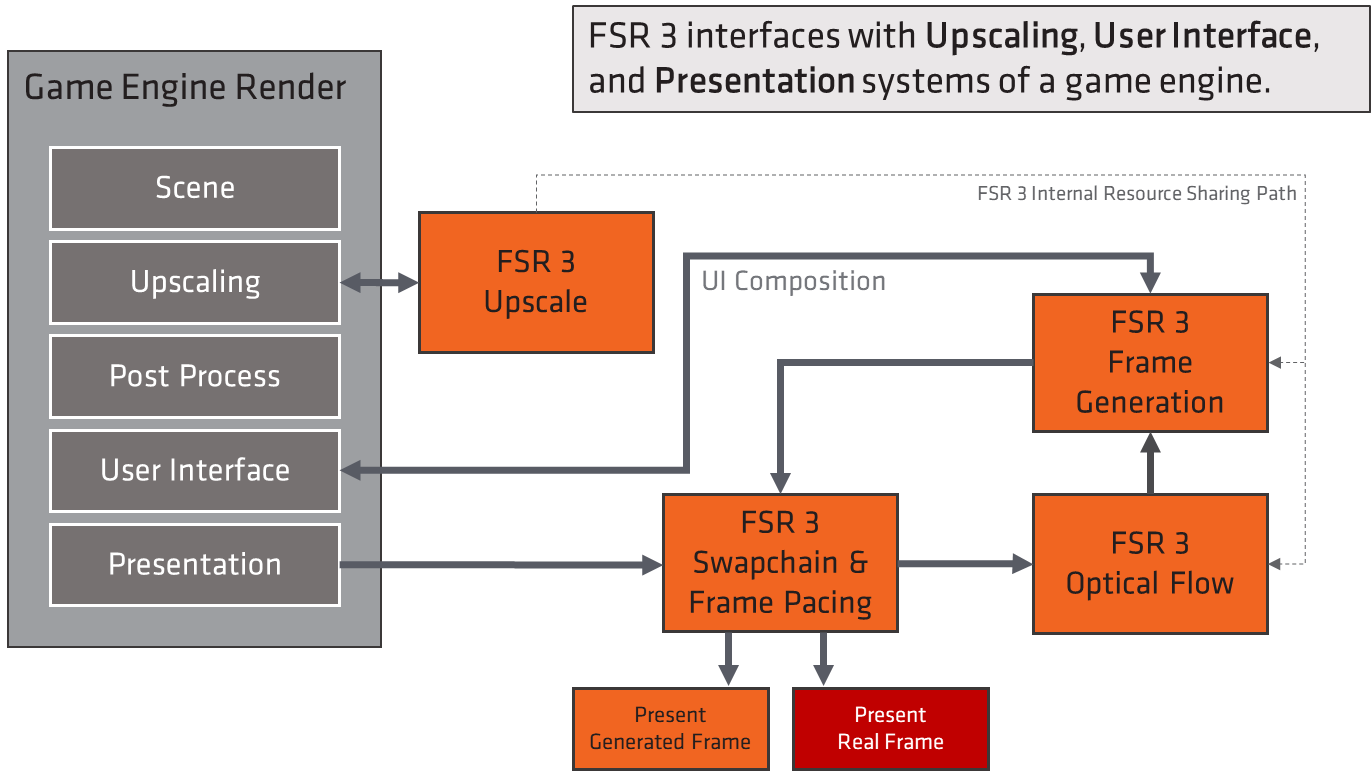
AMD FSR 3 technology extends upon FSR 2’s upscaling by adding Frame Generation – the ability to generate entirely new game frames and present those to the user to improve FPS. FSR 3 does this by adding two new technologies – Frame Interpolation and Optical Flow enhanced from AMD Fluid Motion Frames2.
With AMD FSR 3, development focused purely on providing a great experience using Frame Generation. AMD FSR 3 Frame Generation is supported on a variety of GPU hardware and is not limited to desktop platforms. AMD FSR 3 Frame Generation is recommended to be used in situations where pre-interpolation, post-upscaling frame rate is a minimum of 60. In ideal situations FSR 3 will produce images up to 120fps from a 60fps game input.
AMD FSR 3 Frame Generation works by taking the image a game would usually display on the monitor, and instead passing it into the FSR 3 Optical Flow workload. This Optical Flow has been developed from AMD Fluid Motion Frames to introduce both performance and quality improvements when it comes to game frame input. After that computation is complete, we pass results to the AMD FSR 3 Frame Generation workload. These workloads can run in asynchronous compute to reduce the impact on the game render pipeline and produce new game frames which can then be presented.
We also have various methods for how game UI (User Interface) is handled. AMD FSR 3 can provide smooth and fluid 120fps UI, even if the game only provides a full render loop at 60fps. This means any complex UI with animations can be implemented in such a way that animations are true to the display frame rate.
The final decision as to when “real” or “generated” frames are seen by the user is taken by our replacement swapchain implementation – which handles both the asynchronous compute dispatch of the Optical Flow and Frame Generation workloads. It also handles the pacing of frames, and ultimately sending images into the operating system for present on the display.
There are a variety of options available when it comes to combining AMD FSR 3 functionality together, which allows game developers the flexibility to adapt the system into their rendering engine frameworks. The options used can impact how AMD FSR 3 appears to work in different ways, so we wanted to share some of the options available to clarify how implementations differ.
On Windows desktop, using DirectX 12, AMD FSR 3 provides a replacement swapchain which implements our asynchronous workloads and frame pacing. Game developers are recommended to use this swapchain, however as with all AMD FidelityFX technologies – developers can tailor to their needs.
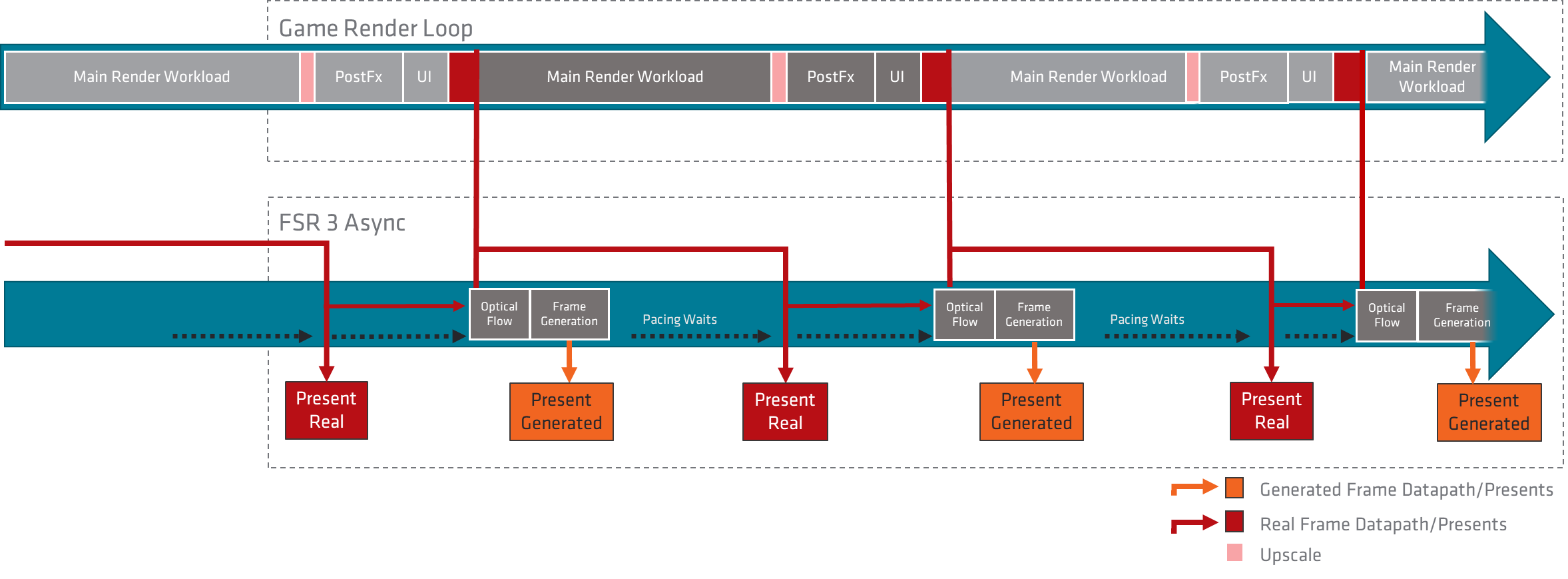
Using the AMD FSR 3 swapchain, VSync enabled and disabled modes are the main differentiators in terms of frame pacing. When VSync is enabled, pacing relies on the expected refresh rate of the monitor and will present game frames as quickly as makes sense – as ultimately, the monitor will swap to the queued frame images in a consistent way behind the scenes. A game using AMD FSR 3 in this configuration will show a “zig-zag” pattern on frame time / present-to-present timing graphs. This is expected.
There are more accurate ways to examine frames through the display pipeline to a monitor than present-present. The gameplay experience in this mode is recommended due to its more consistent timing – when combined with a game-side frame time limiter set to ½ refresh rate, it is a high-quality gaming experience.
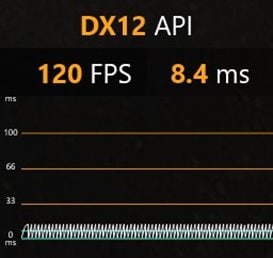
With VSync disabled, the algorithm becomes more complicated. There are methods for when rendering is CPU limited versus GPU limited, and when the ALLOW_TEARING flag is used. Generally, to get the most “frames”, VSync can be disabled on lower refresh monitors with the ALLOW_TEARING flag set. You will see screen tearing, but FPS counters should reflect higher display frame rate.
When VSync is disabled, there are more wait events used in the frame pacing system to maintain present to present timing which should read to a smoother frame-time graph, rather than the zig-zag when VSync is enabled. However, the gameplay experience when using low-refresh monitors is unlikely to benefit from this.
With the Unreal Engine 5 plugin, there are more options to provide a starting point for supporting non-Windows platforms and that control frame pacing and how UI is composited.
The AMD FSR 3 UE5 plugin contains two backend types: RHI and Native DirectX® 12.
The RHI backend is platform agnostic and should work effectively in most circumstances. However, it does not support asynchronous execution of the AMD FSR 3 compute workloads so these jobs are serialized, with an associated performance cost. Additionally, frame pacing is handled by Unreal’s underlying presentation framework. The ideal use for AMD FSR 3 using the RHI backend is when VSync is enabled on a high-refresh 120+ Hz monitor. One benefit of the RHI backend is that the user interface is natively rendered onto both the interpolated and real frames, for artefact-free clarity.
The Native DX12 backend fully supports asynchronous workloads and full frame pacing, so can have higher performance in certain circumstances. The UI rendering in the Native DX12 backend occurs via a “HUD-less” system whereby AMD FSR 3 is provided with a version of the scene before UI is rendered on top. Using this, the AMD FSR 3 algorithm applies different techniques to maintain UI clarity, but there is possibility for certain UI techniques that could introduce artefacts.
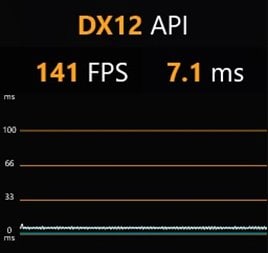
With many things in software engineering, each method has trade-offs, but we have designed AMD FSR 3 with flexibility in mind so that game developers can choose what makes sense for their own products. It should be noted that the titles introduced with AMD FSR 3 integrations can go whichever way they desire, and whilst we have recommendations, it’s ultimately the game developer’s decision on what method to implement.
Another item to note is the setup and aim. If you have a 120hz monitor, and the game without FSR 3 Frame Generation runs at 90fps – and you enable VSync – you will be dropping interpolated frames to your monitor’s 120hz refresh rate. In this instance, it will be wise to either disable VSync, or to limit the game FPS using its in-game settings to the required monitor refresh rate. This allows you to trade off smooth pacing for latency3,4, in games where this choice makes a difference.
Additionally, it is recommended that Enhanced Sync is disabled in AMD Software: Adrenalin Edition settings, as it can interfere with frame pacing logic.
Interpolating a frame adds latency – this is by design. However, AMD FSR 3 was developed to minimize the impact of latency via built-in latency reduction technology. Game developers can also implement generic and cross-platform recommendations to minimize the impact of latency in their titles.
| GPU / Setting | FSR 3 “Performance” Mode + Frame Generation | FSR 3 “Performance” Mode | FSR 3 OFF |
|---|---|---|---|
| AMD Radeon™ RX 7900 XTX (4K) | 55 ms | 48 ms | 81 ms |
| AMD Radeon™ RX 6800 XT (1440p) | 58 ms | 55 ms | 81 ms |
| GPU / Setting | FSR 3 “Performance” Mode + Frame Generation | FSR 3 “Performance” Mode | FSR 3 OFF |
|---|---|---|---|
| AMD Radeon™ RX 7900 XTX (4K) | 40 ms | 37 ms | 72 ms |
| AMD Radeon™ RX 6800 XT (1440p) | 43 ms | 37 ms | 63 ms |
Through our testing, we have seen that latency is within expectations. The latency induced from enabling both AMD FSR 3 upscaling and frame generation is typically less than the native rendering experience without AMD FSR 3 enabled.
AMD FidelityFX Super Resolution 3.0, as with previous AMD FSR releases, will be made available soon on GPUOpen with a permissive open source MIT license. If you are interested in evaluating AMD FSR 3 for your game title, please contact your AMD representative to request early access.
We cannot wait to see how developers use this technology to enable smoother experiences in their games! We already have these games planning to integrate AMD FSR 3 technology in the future:
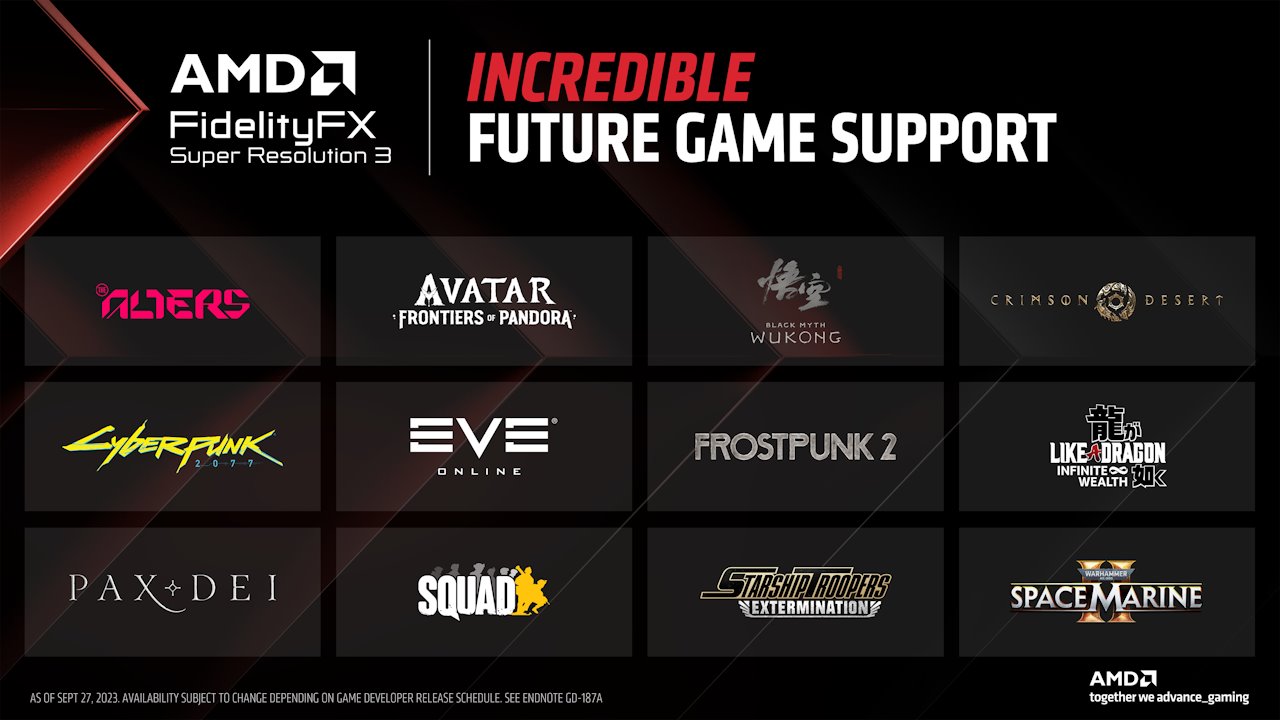
Want to make sure you’re the first to hear when it’s ready? Then make sure to follow us on X (Twitter) @GPUOpen or Mastodon, add our RSS feed, or just keep popping back here.
And if you want to read more today about AMD FSR 3, head on over to the amd.com blog aimed at gamers, where you can read more about today’s game integration news.
Links to third-party sites are provided for convenience and unless explicitly stated, AMD is not responsible for the contents of such linked sites, and no endorsement is implied. GD-98
11 BIT STUDIOS®, FROSTPUNK 2® are registered trademarks of 11 BIT STUDIOS S.A. © 11 BIT STUDIOS S.A. All other marks and trademarks are the property of their respective owners. All rights reserved.
The Alters © 2022 11 BIT STUDIOS S.A. All rights reserved.
Avatar: Frontiers of Pandora™ © 2023 20th Century Studios. Game Software excluding 20th Century Studios elements: © 2023 Ubisoft Entertainment. All Rights Reserved. Avatar: Frontiers of Pandora™ and the 20th Century Studios logo are trademarks of 20th Century Studios. Licensed to Ubisoft Entertainment by 20th Century Studios. Ubisoft and the Ubisoft logo are registered or unregistered trademarks of Ubisoft Entertainment in the U.S. and/or other countries.
Black Myth: Wukong copyright © Game Science Interactive Technology Co., Ltd. All Rights Reserved
CD PROJEKT®, CD PROJEKT RED®, the CD PROJEKT RED® logo, Cyberpunk®, Cyberpunk 2077®, and the Cyberpunk 2077® logo are registered trademarks of CD PROJEKT S.A. © 2020 CD PROJEKT S.A. All rights reserved.
Crimson Desert copyright © Pearl Abyss Corp. All Rights Reserved
EVE Online® and the EVE Online logo are the registered trademarks of CCP ehf. All rights are reserved worldwide. All other trademarks are the property of their respective owners. EVE Online, the EVE Online logo, EVE, and all associated logos and designs are the intellectual property of CCP ehf. CCP Games and the CCP logo are the registered trademarks of CCP ehf.
FORSPOKEN © 2023 SQUARE ENIX CO., LTD. All Rights Reserved.
Immortals of Aveum © 2023 Electronic Arts Inc.
Like a Dragon: Infinite Wealth © SEGA. All rights reserved. SEGA is registered in the U.S. Patent and Trademark Office. SEGA, the SEGA logo, Yakuza and LIKE A DRAGON are registered trademarks or trademarks of SEGA CORPORATION or its affiliates. All other trademarks, logos and copyrights are property of their respective owners.
Pax Dei ©2023 Mainframe Industries, all rights reserved. Pax Dei is protected through EU and international trademark registrations of Mainframe Industries. Other trademarks belong to their respective owners.
Squad © 2023 Offworld Industries Ltd. Offworld Industries® and the Offworld logo are both registered Canadian trademarks.
Starship Troopers™ & ©2023 TriStar Pictures, Inc. All Rights Reserved. Published by Offworld Industries Ltd. Game software excluding TriStar Pictures, Inc. elements: © 2023 Offworld Industries Ltd. All Rights Reserved.
Warhammer 40,000: Space Marine 2 © Games Workshop Limited 2022. Space Marine, the Space Marine logo, GW, Games Workshop, Space Marine, 40K, Warhammer, Warhammer 40,000, 40,000, the ‘Aquila’ Double-headed Eagle logo, and all associated logos, illustrations, images, names, creatures, races, vehicles, locations, weapons, characters, and the distinctive likeness thereof, are either ® or TM, and/or © Games Workshop Limited, variably registered around the world, and used under license. Focus Entertainment, Focus Home Interactive and their logos are trademarks or registered trademarks of Focus Home Interactive. Saber Interactive and its logos are trademarks or registered trademarks of Saber Interactive. All rights reserved to their respective owners.
The information contained herein is for informational purposes only, and is subject to change without notice. While every precaution has been taken in the preparation of this document, it may contain technical inaccuracies, omissions and typographical errors, and AMD is under no obligation to update or otherwise correct this information. Advanced Micro Devices, Inc. makes no representations or warranties with respect to the accuracy or completeness of the contents of this document, and assumes no liability of any kind, including the implied warranties of noninfringement, merchantability or fitness for particular purposes, with respect to the operation or use of AMD hardware, software or other products described herein. No license, including implied or arising by estoppel, to any intellectual property rights is granted by this document. Terms and limitations applicable to the purchase or use of AMD’s products are as set forth in a signed agreement between the parties or in AMD’s Standard Terms and Conditions of Sale. GD-18
© 2023 Advanced Micro Devices, Inc. All rights reserved. AMD, the AMD Arrow logo, AMD Software: Adrenalin Edition, AMD Smart Access Memory, AMD Fidelity FX, Radeon, RDNA, and Ryzen, are trademarks of Advanced Micro Devices, Inc. DirectX is either a registered trademark or trademark of Microsoft Corporation in the US and/or other countries. Unreal® is a trademark or registered trademark of Epic Games, Inc. in the United States of America and elsewhere. Other product names used herein are for identification purposes and may be trademarks of their respective owners.